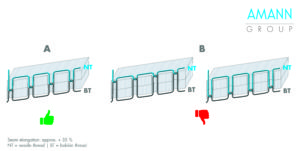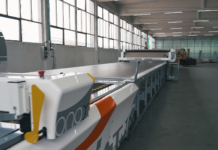 The influence of thread tension settings on stitch balance and seam elongation. The trend of using elastic fabrics for all kind of garments is constantly increasing, as they are comfortable to wear. The challenge of elastic apparel lies in the required elastic seams. The market offers a variety of special sewing threads with higher elasticity for high seam elongation (e.g. Amann’s sabaFlex for sports- and underwear or PremiumGD for Garment Dyeing). The stitch type has a great effect on the elasticity of a seam as well, but due to design or existing machinery, the lockstitch is still the most used stitch type even if it is very inelastic. In order to achieve the best elongation of the lockstitch, the correct tension adjustment is crucial. Correct tension setting in the lockstitch means to place the interlooping of needle and bobbin thread in the middle of the material (A), leading to equal length of needle and bobbin thread when unraveling the seam. Seam elongation tests haven proven, that seams with a correct stitch balance show a higher seam elongation of approx. 35%, compared to seams where the interlocking is on the top/bottom, which means that needle and bobbin thread are not equal in length (B). A well-balanced tension setting is therefore the precondition for high seam elasticity! Sewing thread recommendations for your specific fabric and sewing parameters as well as thread requirement calculations are available on request from Amann‘s technical sewing service.
The influence of thread tension settings on stitch balance and seam elongation. The trend of using elastic fabrics for all kind of garments is constantly increasing, as they are comfortable to wear. The challenge of elastic apparel lies in the required elastic seams. The market offers a variety of special sewing threads with higher elasticity for high seam elongation (e.g. Amann’s sabaFlex for sports- and underwear or PremiumGD for Garment Dyeing). The stitch type has a great effect on the elasticity of a seam as well, but due to design or existing machinery, the lockstitch is still the most used stitch type even if it is very inelastic. In order to achieve the best elongation of the lockstitch, the correct tension adjustment is crucial. Correct tension setting in the lockstitch means to place the interlooping of needle and bobbin thread in the middle of the material (A), leading to equal length of needle and bobbin thread when unraveling the seam. Seam elongation tests haven proven, that seams with a correct stitch balance show a higher seam elongation of approx. 35%, compared to seams where the interlocking is on the top/bottom, which means that needle and bobbin thread are not equal in length (B). A well-balanced tension setting is therefore the precondition for high seam elasticity! Sewing thread recommendations for your specific fabric and sewing parameters as well as thread requirement calculations are available on request from Amann‘s technical sewing service.




